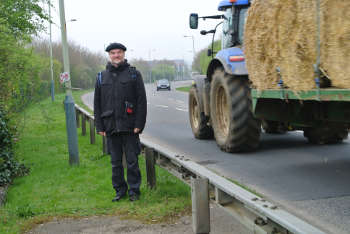How are new housing estates being built without footways on their link roads? This question lies at the heart of the debate about new urban extensions and other schemes continuing to make their residents car dependent.
Campaigners argue residents can be left struggling to reach even local facilities without cars, let alone travel beyond them for work or shopping.
‘Transport for New Homes’ – a fieldwork-based project of the Foundation for Integrated Transport – set out to look into this issue.
It aimed to discover to what extent the sustainable development, liveable communities and healthy life styles described in Government policies for new homes and developers’ masterplans are being delivered in real life.

The link road at Castle Mead
Hardly at all, was the answer given at a recent meeting in central London.
Stephen Joseph, CEO of the Campaign for Better Transport and a trustee of the Foundation, suggested this was probably the foundation’s ‘first real public outing’, and it appears to have its work cut out.
Project lead Jenny Raggett said: ‘I heard many fine words from developers, from planners, and saw all sorts of masterplans for places that all looked wonderful and I began to think, are we really going to get what it says on the tin? Are we really going to get sustainable development, sustainable transport? And I began to look around.
‘The idea [of the project] was to go to about 15 to 20 different sites – to pick a range of developments and look at the planning history of them… get a general idea of what was planned and what was hoped to be. And to speak to the residents and see what they thought.
‘We visited a lot of urban extensions and are visiting more – the project is still ongoing. So far, we’ve discovered that the newer urban extensions, the newer housing estates, are really, we reckon, unsustainable in terms of transport.’
Ms Raggett listed some of the problems the project saw; there was green infrastructure like flood plains but not the public spaces you see in conventional suburbs. In addition, perhaps as a consequence of the way that these places were based around the car, there was practically nobody walking – and not that many places you could actually work to. It was the same with cycling.
Her co-presenter, geographer Dr Joey Talbot, highlighted the case of Castle Mead in Trowbridge Wiltshire, where residents have to walk 200-300 metres on the road or a grass verge to reach the closest local centre because there is no pavement.
There was also a lack of bus priority measures outside the estates and an almost complete absence of new railway stations, Ms Ragget said, but ‘parking seemed to be absolutely everywhere’. Using the car in these places, ‘well it’s a kind of dream really’.
As well as plenty of parking, there is ready access to the trunk and motorway network, junction improvements and capacity improvements to make it easier for you to drive. People not only drive to such places but also drive a long way, the project found.
The discussion turned to the question of why transport and new homes are not meshed together in terms of funding and planning.
Ms Raggett argued that the most important part of the spatial planning system that creates such places was the strategic housing market assessment, which bases decisions on expected population trends, ‘whereas geography doesn’t really come into it’.
‘At each stage of the planning system, transport isn’t really there. The trouble is transport is added on after the location is decided and then funding is a complete nightmare.’
She acknowledged that the issue was a disconnect between planning and transport funding. Planners know their jobs but cannot get the funding, she said. As for how the situation can be improved: ‘Plan new homes and transport together with co-ordinated funding.’
Paul Crick, vice chair of the ADEPT transport board, agreed that transport is too often added in afterwards – which is too late to change people’s travel patterns. Infrastructure needs to be put in upfront – at the very start, he argued.
Mr Crick agreed that a solution could be the use of more mechanisms to bring forward early investment in infrastructure to influence transport patterns early. Funding is a big issue for local authorities and identifying other sources was important in getting transport infrastructure in early.
He cited the Community Infrastructure Levy as employing ‘no discipline’ over infrastructure where an upper tier authority has no control over what funding is spent on.
Possible solutions include tax increment financing and allocating a share of stamp duty.
Summing up the crux of the problem, he said: ‘Integrated transport should be embedded in the planning system, because it isn’t at the moment. ‘
Register now for full access
Register just once to get unrestricted, real-time coverage of the issues and challenges facing UK transport and highways engineers.
Full website content includes the latest news, exclusive commentary from leading industry figures and detailed topical analysis of the highways, transportation, environment and place-shaping sectors.
Use the link below to register your details for full, free access.
Already a registered? Login